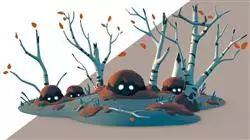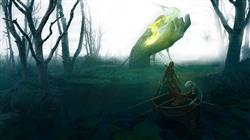University certificate
The world's largest faculty of video games”
Introduction to the Program
Do you want to dedicate yourself to Organic 3D Modeling? This program will give you the opportunity to learn from the best in the industry"

The current realism that many video games present can be separated into two branches. There are the deliveries that provide incredible cinematics, with countless realistic effects and that introduce the user in a scene almost similar to that of a movie. On the other hand, there are also titles with fantasy worlds and characters that are out of proportion to reality: long arms, bulging eyes, mouths with fangs, etc. In both cases, they have one thing in common, they have been made following a Organic 3D Modeling system.
In this sense, this technique has come to be considered as an art in itself, in which it is not only enough to have artistic and aesthetic notions, but also necessary to have technical knowledge to handle the tools used for this purpose. Likewise, the basis of modeling focuses on the millimetric control of the elements that affect the geometry (textures, topology, smoothing, etc.), thus obtaining a higher visual quality of the character or the environment that is designed.
For all these reasons, many professionals have begun to specialize in this field, becoming an indispensable requirement for those video game programmers who wish to work with large companies or independently.
Under this premise, this program has been devised, which not only seeks to provide theoretical knowledge about the tools used for Organic 3D Modeling, but goes a step further: to help the video game developers to improve their professional profile. This will be supported by different real cases presented by experts in the sector and by performing practical exercises to polish their skills.
All this condensed in a program that allows a direct qualification, in which it will not be necessary to do a final work to start practicing as a specialist in the area. Likewise, the teaching methodology allows special emphasis to be placed on those competencies that are necessary to achieve professional success.
Knowing and handling Organic 3D Modeling will allow you to become professionally independent and undertake your own projects”
This Professional master’s degree in Organic 3D Modeling contains the most complete and up-to-date scientific program on the market. Its most notable features are:
- The development of case studies presented by experts in 3D modeling
- The graphic, schematic, and practical contents with which they are created, provide practical information on the disciplines that are essential for professional practice
- Practical exercises where the self-assessment process can be carried out to improve learning
- Its special emphasis on innovative methodologies
- Theoretical lessons, questions to the expert, debate forums on controversial topics, and individual reflection assignments
- Content that is accessible from any fixed or portable device with an Internet connection
Today is a good time to start learning. Don't delay any longer and you'll find that career opportunity you're looking for”
The program’s teaching staff includes professionals from the sector who contribute their work experience to this training program, as well as renowned specialists from leading societies and prestigious universities.
The multimedia content, developed with the latest educational technology, will provide the professional with situated and contextual learning, i.e., a simulated environment that will provide immersive training programmed to train in real situations.
This program is designed around Problem-Based Learning, whereby the professional must try to solve the different professional practice situations that arise during the academic year. For this purpose, the student will be assisted by an innovative interactive video system created by renowned and experienced experts.
Creating figures in Organic 3D Modeling is not easy, but in this program you will discover the tricks of the pros to achieve it”

Hold a university degree from one of the largest digital universities in the world: TECH”
Why study at TECH?
TECH is the world’s largest online university. With an impressive catalog of more than 14,000 university programs available in 11 languages, it is positioned as a leader in employability, with a 99% job placement rate. In addition, it relies on an enormous faculty of more than 6,000 professors of the highest international renown.

Study at the world's largest online university and guarantee your professional success. The future starts at TECH”
The world’s best online university according to FORBES
The prestigious Forbes magazine, specialized in business and finance, has highlighted TECH as “the world's best online university” This is what they have recently stated in an article in their digital edition in which they echo the success story of this institution, “thanks to the academic offer it provides, the selection of its teaching staff, and an innovative learning method aimed at educating the professionals of the future”
A revolutionary study method, a cutting-edge faculty and a practical focus: the key to TECH's success.
The most complete study plans on the university scene
TECH offers the most complete study plans on the university scene, with syllabuses that cover fundamental concepts and, at the same time, the main scientific advances in their specific scientific areas. In addition, these programs are continuously being updated to guarantee students the academic vanguard and the most in-demand professional skills. In this way, the university's qualifications provide its graduates with a significant advantage to propel their careers to success.
TECH offers the most comprehensive and intensive study plans on the current university scene.
A world-class teaching staff
TECH's teaching staff is made up of more than 6,000 professors with the highest international recognition. Professors, researchers and top executives of multinational companies, including Isaiah Covington, performance coach of the Boston Celtics; Magda Romanska, principal investigator at Harvard MetaLAB; Ignacio Wistumba, chairman of the department of translational molecular pathology at MD Anderson Cancer Center; and D.W. Pine, creative director of TIME magazine, among others.
Internationally renowned experts, specialized in different branches of Health, Technology, Communication and Business, form part of the TECH faculty.
A unique learning method
TECH is the first university to use Relearning in all its programs. It is the best online learning methodology, accredited with international teaching quality certifications, provided by prestigious educational agencies. In addition, this disruptive educational model is complemented with the “Case Method”, thereby setting up a unique online teaching strategy. Innovative teaching resources are also implemented, including detailed videos, infographics and interactive summaries.
TECH combines Relearning and the Case Method in all its university programs to guarantee excellent theoretical and practical learning, studying whenever and wherever you want.
The world's largest online university
TECH is the world’s largest online university. We are the largest educational institution, with the best and widest online educational catalog, one hundred percent online and covering the vast majority of areas of knowledge. We offer a large selection of our own degrees and accredited online undergraduate and postgraduate degrees. In total, more than 14,000 university degrees, in eleven different languages, make us the largest educational largest in the world.
TECH has the world's most extensive catalog of academic and official programs, available in more than 11 languages.
Google Premier Partner
The American technology giant has awarded TECH the Google Google Premier Partner badge. This award, which is only available to 3% of the world's companies, highlights the efficient, flexible and tailored experience that this university provides to students. The recognition as a Google Premier Partner not only accredits the maximum rigor, performance and investment in TECH's digital infrastructures, but also places this university as one of the world's leading technology companies.
Google has positioned TECH in the top 3% of the world's most important technology companies by awarding it its Google Premier Partner badge.
The official online university of the NBA
TECH is the official online university of the NBA. Thanks to our agreement with the biggest league in basketball, we offer our students exclusive university programs, as well as a wide variety of educational resources focused on the business of the league and other areas of the sports industry. Each program is made up of a uniquely designed syllabus and features exceptional guest hosts: professionals with a distinguished sports background who will offer their expertise on the most relevant topics.
TECH has been selected by the NBA, the world's top basketball league, as its official online university.
The top-rated university by its students
Students have positioned TECH as the world's top-rated university on the main review websites, with a highest rating of 4.9 out of 5, obtained from more than 1,000 reviews. These results consolidate TECH as the benchmark university institution at an international level, reflecting the excellence and positive impact of its educational model.” reflecting the excellence and positive impact of its educational model.”
TECH is the world’s top-rated university by its students.
Leaders in employability
TECH has managed to become the leading university in employability. 99% of its students obtain jobs in the academic field they have studied, within one year of completing any of the university's programs. A similar number achieve immediate career enhancement. All this thanks to a study methodology that bases its effectiveness on the acquisition of practical skills, which are absolutely necessary for professional development.
99% of TECH graduates find a job within a year of completing their studies.
Postgraduate Diploma in 3D Human Modeling
.
The 3D model in the development of video games plays a fundamental role in the creation of realistic characters and environments; for this reason, the creation centers of the sector seek specialized professionals who can provide a competent service that allows them to achieve the desired objectives. The Master in Organic 3D Modeling of TECH Global University is an excellent opportunity for academic qualification, because we have an innovative study plan, which was structured by the best experts in the field. The acquired sapiences will empower the student to create any kind of living being, including its clothing and distinctive features, so that it can be distinguished from other characters easily.
Postgraduate in Organic 3D Modeling 100% online
.
The Postgraduate Diploma in 3D Human Modeling TECH seeks not only to offer an optimal theoretical background, but also to provide communication skills that allow the professional to adapt to any workflow imposed by the industry, offering solutions that promote the success of the video game. Likewise, students will learn how to create the skeleton of a character using a rig to check the functionality of the product and correct bugs. Moreover, they will be instructed on how to use the best design software in the field of sculpting and modeling, mastering Unreal Engine and Blender more effectively than most professionals in the job market.







